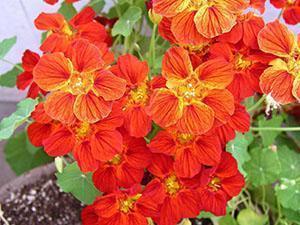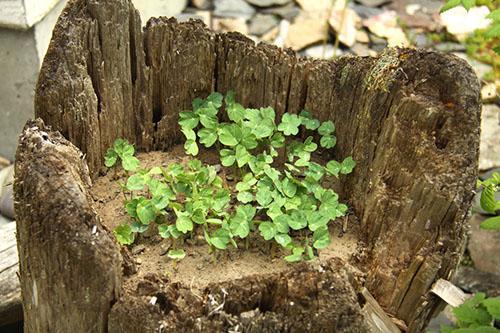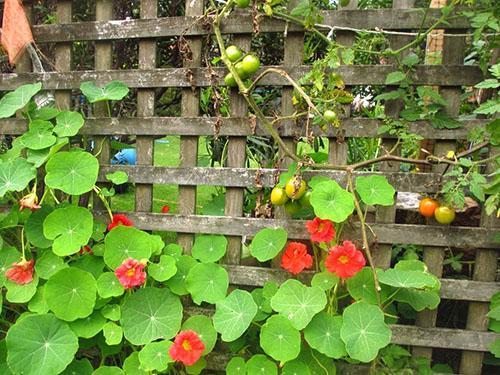Growing and caring for unpretentious nasturtium
 In the warm climate of South America, where nasturtium comes from, these plants are often grown as perennials, producing lush flower hats almost all year round. But neither powerful stems nor fleshy roots can survive the Russian winters.
In the warm climate of South America, where nasturtium comes from, these plants are often grown as perennials, producing lush flower hats almost all year round. But neither powerful stems nor fleshy roots can survive the Russian winters.
Therefore, the culture is well known to domestic gardeners as a spectacular annual, pleasing with flowering almost throughout the summer. First buds on nasturtium, planting of which with seeds or seedlings is not so difficult even for a beginner grower, appear in mid-June or July, and the last flowers under a wave of autumn frosts.
In order for the plant to give green mass earlier and enter the flowering time, it is necessary:
- choose a planting site for nasturtium correctly;
- provide seedlings with proper care, including watering and feeding;
- protect stems, flowers and leaves from pests and diseases.
Much also depends on the planting material.
Common types of nasturtium are propagated by seeds that mature in temperate climates and can be used for sowing next season.
Planting nasturtium in the garden

The high density of organic-rich soil can play a bad joke with the grower. Not only will the seeds have serious difficulties with germination, so the young plant will begin to "fatten", giving a lot of foliage, not flowers. If the soil with a high clay content or black soil is also excessively moistened, the roots of the nasturtium quickly rot and the plant dies.
The best choice of a site for planting nasturtium is sandy loam or loam with good drainage, regular watering and fertilizing, if necessary.
There is a well-known saying about "feet warm and head cold." The opposite is true for nasturtium. With all the love of this culture for warmth and light, it is important to choose a place so that the roots of the plant are shaded. But foliage and flowers exposed to the sun will be able to show themselves in full force, especially if they are protected from wind and possible frost.
 A trellis, a garden fence or a wall of a backyard building perfectly cope with the role of a support for climbing and climbing species of nasturtium. Bush forms are good in flower beds, and ampelous ones are good in hanging pots or decorative flowerpots.
A trellis, a garden fence or a wall of a backyard building perfectly cope with the role of a support for climbing and climbing species of nasturtium. Bush forms are good in flower beds, and ampelous ones are good in hanging pots or decorative flowerpots.
Planting methods for nasturtium
 There are three main ways to plant and grow nasturtium:
There are three main ways to plant and grow nasturtium:
- Obtaining nasturtium from seeds simplifies the process of plant acclimatization, seedlings take root without any problems in the heated soil and grow actively.
- The seedling method of planting a crop allows you to bring flowering closer and make it longer, but there is a risk of losing seedlings after transfer to the soil.
- With the help of cuttings, which quickly grow roots in wet sand or water and are ready to be planted in a permanent place in the garden. This method is irreplaceable when it is not possible to obtain seeds of an exotic species or a new variety.
In addition, some types of nasturtium form tubers suitable for winter storage at temperatures close to zero and spring planting into the ground.
Growing nasturtium from seeds
 Most types of cultivated nasturtium can be grown from seed, bypassing the seedling stage. This method saves a lot of time and effort. Nasturtium, the cultivation and care of which begins with seeds, initially develops in the open field and does not get sick. The only negative is that you can see blooming nasturtium in the garden only by the middle of summer.
Most types of cultivated nasturtium can be grown from seed, bypassing the seedling stage. This method saves a lot of time and effort. Nasturtium, the cultivation and care of which begins with seeds, initially develops in the open field and does not get sick. The only negative is that you can see blooming nasturtium in the garden only by the middle of summer.
And sometimes gardeners complain that the seeds do not want to hatch at all. This can happen due to:
- poor quality or immaturity of the seeds themselves;
- too cold soil during planting of nasturtium;
- excess moisture in the soil;
- strong burial of seeds;
- high soil density in the place chosen for nasturtium.
In order not to face these troubles, before sowing, the seeds are immersed in water from 40 to 50 ° C for a quarter of an hour and then soaked for another day. This activates the sprout and softens the dense surface skin.
Planting of nasturtium is carried out in May, only in a sufficiently warm soil. In holes located at a distance of 20-30 cm, two or three seeds are lowered to a depth of 2 cm.
Seedlings of nasturtium do not tolerate cold snaps and during frosts need to be protected with covers made of film or non-woven material. The same technique, like watering with warm water, will make the plants grow faster.
Planting nasturtium seedlings for early flowering
 The main danger of the seedling method of growing nasturtium is the risk of damage to the sufficiently succulent and brittle roots of the plant, so the seeds are sown in separate containers to avoid picking and transfer into the ground along with an earthen clod.
The main danger of the seedling method of growing nasturtium is the risk of damage to the sufficiently succulent and brittle roots of the plant, so the seeds are sown in separate containers to avoid picking and transfer into the ground along with an earthen clod.
It is even better if for planting nasturtium peat tablets are used or pots.
- Sowing in April or early May is carried out to a depth of not only 2 cm, 2-3 seeds per hole.
- Landings need to provide an air temperature of about +22 ° C.
- When shoots appear in two weeks, the temperature slightly, up to + 18 ° C, reduces and organizes good lighting for the shoots.
 Plants can be transferred to the garden if the threat of frost has passed. Most often this happens by mid-May, less often in June. If bad weather or cool nights awaits after planting nasturtium, it is better to protect the plantation with a covering material.
Plants can be transferred to the garden if the threat of frost has passed. Most often this happens by mid-May, less often in June. If bad weather or cool nights awaits after planting nasturtium, it is better to protect the plantation with a covering material.
And the gardener can take the first photos of nasturtium flowers in a month or a month and a half after planting seedlings in the ground. Flowering will end only with the onset of stable cold weather.
Growing and caring for nasturtium during the summer
 Taking care of nasturtium during the summer months is a snap. The plant requires only regular but moderate watering and weeding in the root zone. If you take care of mulching the loosened soil in advance, then both mandatory measures are greatly simplified and required less often.
Taking care of nasturtium during the summer months is a snap. The plant requires only regular but moderate watering and weeding in the root zone. If you take care of mulching the loosened soil in advance, then both mandatory measures are greatly simplified and required less often.
The mode and method of irrigation for nasturtium is chosen so that moisture does not stagnate and does not remain on the greenery during hot times of the day. Otherwise, instead of being useful, watering can lead to rotting of the roots and sunburn of foliage and flowers.
Lack of water during cultivation and care of nasturtium causes disproportionate elongation and weakening of the stems, crushing and yellowing of leaves, massive shedding of flowers and buds. A weakened plant can be supported by mineral feeding, as well as by regular pruning of old and dry stems, removal of withered leaves and corollas.
If signs of disease or traces of pests are found on the nasturtium, the damaged parts of the plant are removed and destroyed, and the crown is treated with insecticides or other drugs.
Collecting nasturtium seeds in the garden
 Many types of nasturtium that are widespread in Russia, in addition to foreign ones, give seeds suitable for planting. It is not difficult to collect fruits with three seeds under a thick folded rind that are formed on the spot.
Many types of nasturtium that are widespread in Russia, in addition to foreign ones, give seeds suitable for planting. It is not difficult to collect fruits with three seeds under a thick folded rind that are formed on the spot.
If you look at nasturtium and a photo of flowers, you can see how, increasing in size, the fruits change color from bright green to pale.This is a ripening process, and then the seeds, ready for germination, with a dried skin fall off and remain viable for at least four years.
 When to harvest nasturtium seeds to prevent spontaneous sowing? Indeed, unlike the stems and leaves, nasturtium seeds are not afraid of frost and will definitely start growing even in autumn, but the sprouts will not be able to overwinter.
When to harvest nasturtium seeds to prevent spontaneous sowing? Indeed, unlike the stems and leaves, nasturtium seeds are not afraid of frost and will definitely start growing even in autumn, but the sprouts will not be able to overwinter.
The average ripening period for cultivated species is 40 days after the appearance of the flower. When collecting, they are guided by this period. If the coming frosts force you to pluck still green seeds, they can be made to ripen by drying and stirring at room temperature for 1-2 months.